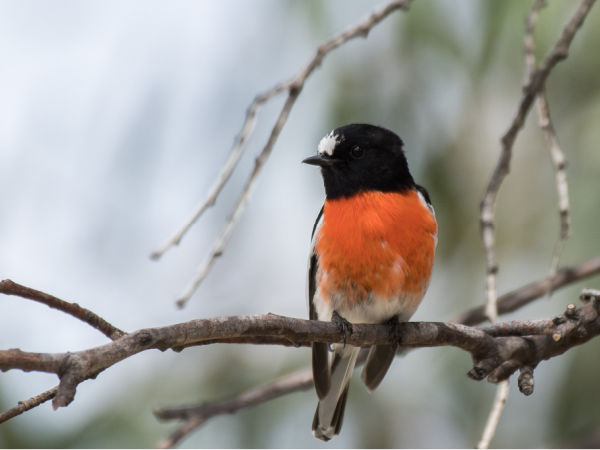 The Scarlet Robin Petroica boodang, is a small, plump bird, to 130 mm. Males have a striking scarlet breast, black head, neck and upper parts with a conspicuous small white patch above the bill. The lower underparts are white. The wings are barred white and the outer tail is also white.
The Scarlet Robin Petroica boodang, is a small, plump bird, to 130 mm. Males have a striking scarlet breast, black head, neck and upper parts with a conspicuous small white patch above the bill. The lower underparts are white. The wings are barred white and the outer tail is also white.
Females are brown above with an orange-red breast, white forehead and brown wings and white underparts. Young birds resemble females but are streaked white above, tinged buff on the wings and are mottled dark-brown on the breast and sides of the body.
Scarlet Robins can be quite tame around humans. They are a quiet and unobtrusive species which is often easily approached. They are particularly affected by the removal of understorey. Their conservation Status is Vulnerable in NSW.
Habitat Requirements – Home and Food
The Scarlet Robin:
- feeds mainly on insects and forages on or near the ground. It sit on a perch and fly down to catch prey. Sometimes they forage in mixed flocks with other small insect-eating birds, such as Flame and Hooded Robins, Weebills, Grey Fantails and thornbills;
- lives in dry eucalypt forests and woodlands where the understorey is usually open and grassy with few scattered shrubs. They live in both mature and regrowth vegetation;
- occasionally occurs in mallee or wet forest communities, or in wetlands and tea-tree swamps;
- habitat usually contains abundant logs and fallen timber, important components of its habitat;
- breeds on ridges, hills and foothills of the western slopes, the Great Dividing Range and eastern coastal regions; and is occasionally found up to 1000 metres in altitude;
- is primarily a resident in forests and woodlands, but some adults and young birds disperse to more open habitats after breeding;
- in autumn and winter many individuals live in open grassy woodlands and grasslands or grazed paddocks with scattered trees;
- forage from low perches, fence-posts or on the ground, from where they pounce on small insects and other invertebrates which are taken from the ground, or off tree trunks and logs; they sometimes forage in the shrub or canopy layer;
- pairs defend a breeding territory and mainly breed between July and January raising two or three broods each season;
- nests are an open cup made of plant fibres and cobwebs built in the fork of tree usually more than two metres above the ground; nests are often found in a dead branch in a live tree, or in a dead tree or shrub;
- eggs are pale greenish, bluish or brownish-white, spotted with brown with clutch size ranging from one to four;
- birds usually occur singly or in pairs, occasionally in small family parties and pairs stay together year-round; and
- in autumn and winter join mixed flocks of other small insectivorous birds which forage through dry forests and woodlands.
Threats
- Their habit of foraging on the ground for food makes them vulnerable to cats, and young birds that roost close to the ground may be taken by rats.
- Historical habitat clearing and degradation.
- Habitat modification due to overgrazing.
- Reduction of size of remnant patches.
- Reduction in the structural complexity of habitat, including reductions in canopy cover, shrub cover, ground cover, logs, fallen branches and leaf litter.
- Reduction of the native ground cover in favour of exotic grasses.
- Loss of nest sites, food sources and foraging sites, such as standing dead timber, logs and coarse woody debris from depletion by grazing, firewood collection and ‘tidying up’ of rough pasture.
- Predation by over-abundant populations of Pied Currawong (Strepera graculina) which are supported by planted exotic berry-producing shrubs; this pressure, is addition to that from other native and exotic predators, may be a potentially severe threat to the breeding success of Scarlet Robin populations.
- Isolation of patches of habitat, particularly where these patches are smaller than ten hectares, and in landscapes where clearing has been heavy or where remnants are surrounded by cropping or stock grazing.
- Habitat for the Scarlet Robin may become unsuitable if dense regeneration occurs after bushfires or other disturbances.
- Competitive exclusion by over-abundant Noisy Miners (Manorina melanocephala) within habitat.
 The Scarlet Robin Petroica boodang, is a small, plump bird, to 130 mm. Males have a striking scarlet breast, black head, neck and upper parts with a conspicuous small white patch above the bill. The lower underparts are white. The wings are barred white and the outer tail is also white.
The Scarlet Robin Petroica boodang, is a small, plump bird, to 130 mm. Males have a striking scarlet breast, black head, neck and upper parts with a conspicuous small white patch above the bill. The lower underparts are white. The wings are barred white and the outer tail is also white.